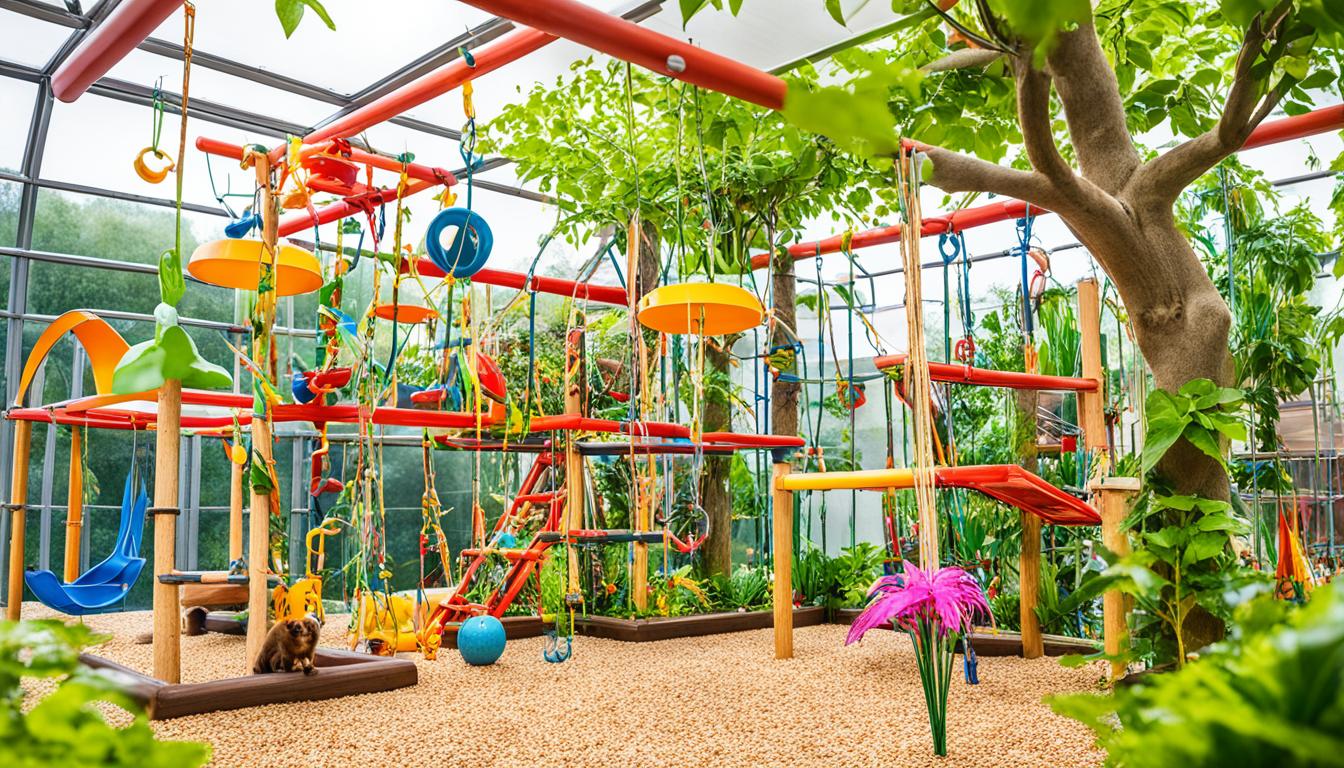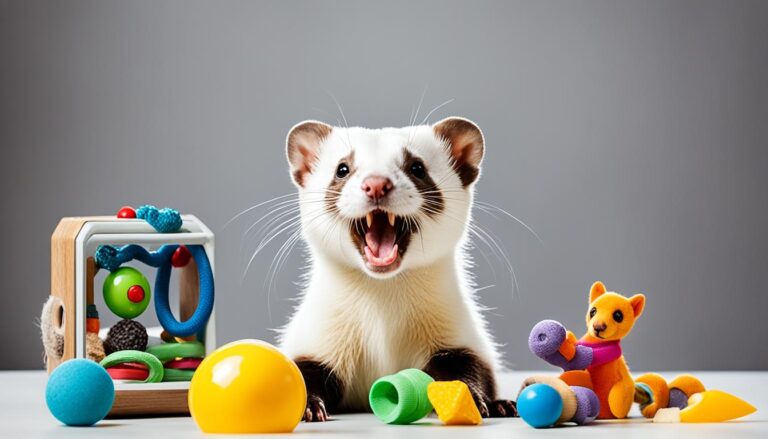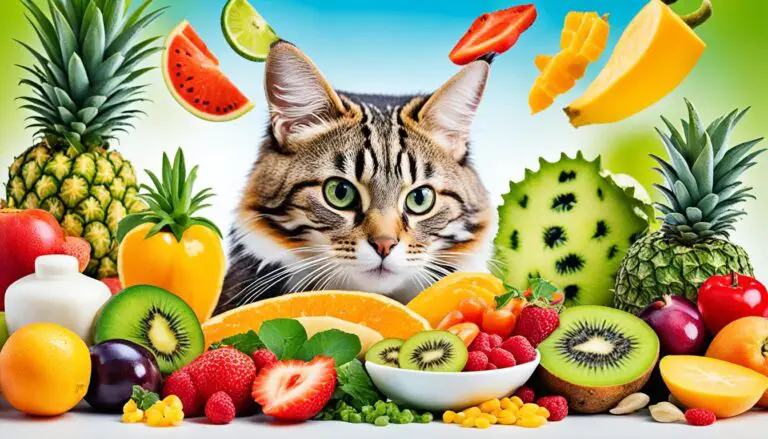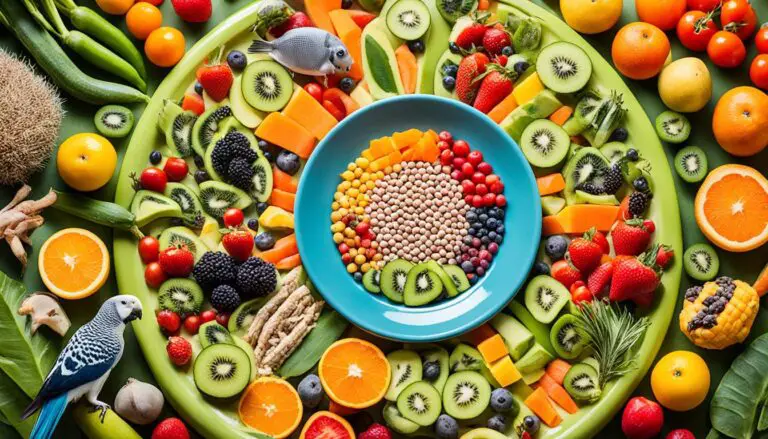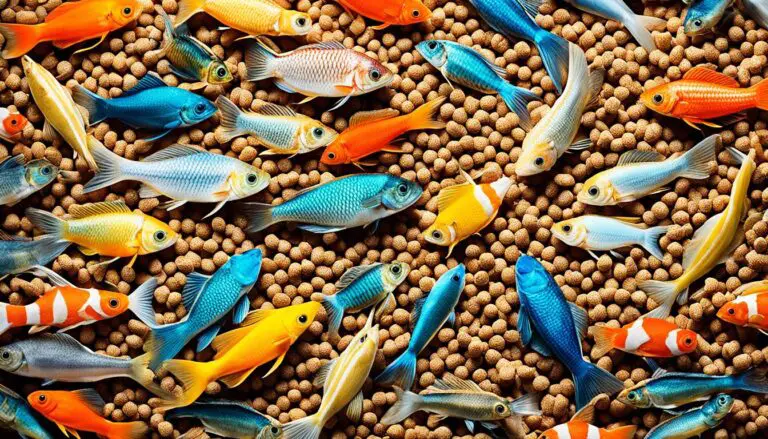Exotic Pet Enrichment and Toys Guide
Enrichment is key for the well-being of exotic pets. This includes birds, rodents, rabbits, and raccoons. They need both physical and mental activities to be happy in captivity. Without these, they might get bored, anxious, or start destructive habits.
For exotic pets, there are many toys and activities available. These engage their senses and encourage natural behaviors. It’s vital to keep these pets’ minds and bodies active, whether they’re furry or feathered.
- Provide toys for shredding, tunnels for exploration, and exercise wheels to fulfill their need for movement and exercise.
- Introduce foraging and puzzle-solving activities to promote their natural behaviors and mental stimulation.
- Engage their senses through visual, auditory, olfactory, and tactile enrichment.
- Ensure they have hiding spots and secure enclosures to create a sense of security.
This guide looks at various exotic pet enrichment options. From doing it yourself to using food-based or social methods, you’ll learn to improve your pet’s environment. Let’s make their lives more interesting and meaningful.
Key Takeaways:
- Enrichment is crucial for exotic pets, keeping them from getting bored and destructive.
- These pets need toys and activities that engage their senses, encourage natural actions, and offer exercise.
- Enrichment types include movement, foraging, sensory, and social activities.
- DIY options are a great, budget-friendly way to meet your exotic pet’s unique needs.
- Using enrichment ideas can improve your exotic pets’ habitats and joy, boosting their overall well-being.
Enrichment for Exotic Pets
Enrichment changes an animal’s space to let them do what’s natural. This makes their life better. You can use stuff everyone has at home. It fits the needs of each weird pet.
They love toys to move and play like toys for shredding, tunnels, and wheels. Hanging toys also keep them thinking and active. This kind of fun keeps exotic pets healthy and happy.
Pet-safe plants and cardboard puzzles make them think. These games are like real life to them. They include finding food and solving puzzles. It keeps them smart and active.
They also need to use their senses. For their sights, safe places let them hide or watch. This feels like their natural world. It’s important for their mental health.
Changing their home’s look treats their eyes. It can be mirrors or moving things around. Playing nice sounds cheers them up. Talking is good, too. Using smell can be fun. Try new safe scents or their food smells.
Touch is vital. Different stuff like cool stones or soft materials are great. It gives their brains a challenge. This keeps them happy and not bored.
| Enrichment Type | Examples |
|---|---|
| Movement and Exercise | Toys for shredding, tubes or tunnels, exercise wheels, vertical hanging toys |
| Foraging and Puzzle-Solving | Pet-safe plants, cardboard puzzles, hay bins |
| Sensory Enrichment | Visual cues, auditory stimulation, olfactory enrichment, tactile stimulation, hiding spots |

Enrichment activities provide mental stimulation and improve the well-being of exotic pets.
Pet Enrichment Shopping List
Providing fun for your exotic pet is easy. Use everyday stuff from your home. You can make exciting items with simple materials. Here are some cool starting ideas:
Household Items
- Paper towel and toilet paper rolls
- Cardboard boxes
- Bubble wrap
- Plastic containers
- Shredded paper
Craft Materials
- Fleeces
- Polished stones
- Non-toxic paint
- Plastic canvas sheets
- PVC pipe attachments
Miscellaneous Items
- Stuffed animals
- Wooden toy blocks
- Driftwood
- Coconut hides
These items make your pet’s home more fun. They keep your pet thinking and playing. Make sure to use safe materials. They should not be dangerous for your pet.
Being creative can make your exotic pet’s home exciting. Remember, safety is very important. Check that what you use is safe and good for your pet.

Enrichment for Raccoons
Raccoons are smart animals that need a lot of mental challenges. Without enough to do, they can become destructive. It’s key to keep them busy with activities that stimulate their minds and bodies.
Cognitive Enrichment
Tools like puzzle feeders and toys for problem-solving are great for raccoons. They make finding food a fun challenge. Creating mazes with PVC jungle gyms also helps keep raccoons sharp.
Sensory Enrichment
Raccoons love to feel different textures and to see new things. They enjoy playing with safe, textured items. Painting with non-toxic paint brightens their world. They also like sniffing scents from oils or herbs, which adds fun to their day.

Food Enrichment
Keeping raccoons’ minds working with food is very important. Puzzle feeders make mealtime a game. They can also snack on frozen fruits. Sprinkling food around gets them hunting, keeping mealtime fun.
Motor Enrichment
Raccoons need lots of space to move around. Things like climbing structures and swimming opportunity are wonderful for them. These help keep raccoons strong and busy. Raccoons also like sensory saucer swings for exercise.
Social Enrichment
Raccoons like company and playing interactive with toys is helpful. Quality time with them and talking also keeps them happy. Meeting other raccoons can be good too, but should be done carefully. Training is great for their minds and strengthens the bond between you and your raccoon.
DIY Enrichment for Exotic Pets
It’s easy and fun to make enrichment for exotic pets at home. This saves money and keeps your pets happy. Use things you have at home to make toys and hiding places for them.
Foraging is good for your pet’s instincts. Put treats in a paper towel roll or hide food in their space. This makes them search for it, helping their mind work.
DIY puzzle feeders are a fun choice. Make them from PVC pipes and attachments or cut holes in cardboard boxes. Your pets will enjoy the challenge of getting their food out.
Let your pets be creative with paint. Use non-toxic paint for painting activities. It’s a fun way to give them new things to see and do.
Think about different textures too. Use different fabrics or animal fur. This gives your pets a mix of things to feel, making their environment more interesting.
“DIY enrichment is creative and budget-friendly, making life exciting for exotic pets.”
– Exotic Pet Enrichment Expert
Making your own pet things is great for them. It makes their home more fun and deepens your bond with them.

Sensory Enrichment for Exotic Pets
Sensory enrichment is key to keeping exotic pets happy and healthy. It involves exciting their senses to make sure they’re mentally active. We’ll share some ideas on how to do this.
Visual Enrichment
For visual fun, try bubble blowers that make safe bubbles. Pets love chasing them. Mirrors can give the feeling of having friends around. Changing their space keeps things interesting. They love exploring new things.
Auditory Enrichment
Give your pet different sounds to listen to. Soft music relaxes them. Animal sound recordings awaken their curiosity. Make sure the sounds aren’t too loud and are right for your pet.
Olfactory Enrichment
Use smells to make your pet’s world rich. Safe scents like lavender or eucalyptus calm or excite. Herbs and spices near their home add a new scent experience. Place different foods around to let them sniff out new scents.
Tactile Enrichment
Let your pet feel different textures. Toys made of various fabrics, like soft plush, are great. Include things like sand or branches for a varied feel. Ensure everything is safe for your pet.
Adding these sensory activities to their day helps your pet’s happiness. Pay attention to what they enjoy most and make their enrichment unique.
| Benefits of Sensory Enrichment | Examples |
|---|---|
| Stimulates mental activity | Providing visually stimulating toys or objects |
| Reduces boredom and stress | Playing soothing music or nature sounds |
| Enhances cognitive function | Introducing new scents or food smells |
| Promotes exploration and curiosity | Providing toys with different textures |
Food-Based Enrichment for Exotic Pets
Food-based enrichment keeps exotic pets engaged and happy. It includes fun ways to feed them and presents food creatively. These activities offer both exercise and mental challenge.
Foraging Activities
Foraging is good for exotic pets. It slows down eating and keeps them thinking. Snuffle mats, puzzle feeders, and treat toys make food time a game. Your pet gets to hunt for its food like a treasure hunt.
Food-Filled Surprises
Surprises add fun to meals. Try putting mealworms in apples or treats in ice cubes. This gets your pet moving and thinking.
Scattered Food and Creative Feeding
Scatter food for foraging fun. It lets your pet search for food, just like in the wild. You can also get creative by using things like suet feeders. Or freeze food in ice for a challenge.
“Food-based enrichment is more than eating. It’s about problem-solving and fun. This keeps your unusual pet healthy and happy.” – Dr. Sarah Thompson, Exotic Pet Specialist
| Food-Based Enrichment Ideas for Exotic Pets |
|---|
| 1. Puzzle feeders |
| 2. Snuffle mats |
| 3. Treat-filled toys |
| 4. Frozen fruits or treats |
| 5. Apples filled with mealworms |
| 6. Pumpkins filled with dried bugs |
| 7. Scattering food for foraging |
| 8. Creative feeding methods (suet feeders, food in water or ice) |
Enrichment activities are good for exotic pets. They keep pets mentally and physically active. Use foraging, surprises, and clever feeding to keep them sharp and happy. This will mimic their natural behaviors and keep them engaged.
Motor Enrichment for Exotic Pets
Motor enrichment is key for the health and happiness of exotic pets. It’s all about giving them ways to move and explore. This includes toys and activities that make them play and think.
Climbing and Exploring
Exotic pets that love to climb need special setups. You can use climbing walls, cat trees, or big branches. These items help them act on their natural instincts and check out their space.
Swimming and Water Play
Some pets really enjoy being in the water. For them, think about adding a small swimming area. This is great for reptiles or water-loving mammals.
Interactive Toys and Games
Interactive toys are perfect for keeping exotic pets entertained. Tug toys, puzzle feeders, and toys that give out treats are awesome. Just make sure the toys are safe for your pet.
Species-Specific Enrichment
Each exotic pet has its own needs and likes. So, when choosing activities, know what your pet needs. For example, some might like to climb, while others will enjoy swinging or wheel running.
Tip: Keep your exotic pet’s play area safe. Check toys and gadgets often for any damage. If you’re not sure, ask a vet or an exotic pet expert to help you with motor enrichment.
| Motor Enrichment Ideas for Exotic Pets |
|---|
| Provide climbing walls, cat trees, or large branches |
| Add a swimming pool or shallow basin for water play |
| Offer interactive toys like puzzle feeders and treat-dispensing toys |
| Consider species-specific options like climbing shelves or saucer swings |
Don’t forget, motor enrichment is vital for your exotic pet. It keeps them healthy, entertained, and cheerful.
Social Enrichment for Exotic Pets
Social interaction is key for the happiness of exotic pets. They need friends and activities to be happy. Here’s how you can make your exotic pet’s life better:
- Quality Time: Spend one-on-one time with your pet. Do things they love, like playing gently or just talking to them. This time is crucial for their well-being.
- Playtime: Exotic pets enjoy interactive toys. Pick toys that are fun and make them think. Things like puzzle toys or items they can play with safely are perfect.
- Species-Specific Needs: Learn what your pet needs socially. Some types might like a friend from their own species. Always check with experts to make sure it’s safe for them to be together.
- Training and Communication: Teach them using positive methods. It not only is good for their mind but also for your bond. Try clicker training or teach them to communicate with talk buttons.
By following these tips, you’ll improve your exotic pet’s life. Always focus on what your pet needs and make their environment safe and enjoyable.
Creating a Socially Enriching Environment
Improving your pet’s living space can boost their social life. Here’s how to make their home a happy place:
- Give them hiding spots to feel safe.
- Add things they can climb on and interact with, like perches.
- Put in some plants or branches to make it feel more like their natural home.
Making their home socially rich includes mental and physical activities. Understand what your pet needs socially. Then, give them the right chances to interact with others of their kind. This will make their life fulfilling and enriching.
Conclusion
Enrichment boosts the happiness of exotic pets. With toys, activities, and changes to their home, you can make a fun world for your unique friend.
DIY projects mix creativity with saving money. They let you make each activity fit your pet’s needs. You can find or create fun things to touch, eat, move, and play with others.
Using these ideas, you’ll improve your pet’s home and happiness. Make sure they have what they need to stay happy and healthy. Always think of new ways to keep your pet entertained and comfortable.
FAQ
Why is enrichment important for exotic pets?
What are some examples of enrichment activities for exotic pets?
Can I create my own enrichment for exotic pets?
How can I provide sensory enrichment for my exotic pet?
What are some DIY enrichment ideas for exotic pets?
How can I provide food-based enrichment for my exotic pet?
What are some ways to provide motor enrichment for exotic pets?
How can I provide social interaction for my exotic pet?
Why is sensory enrichment important for exotic pets?
How can enrichment enhance exotic pet habitats?
Source Links
- https://www.amcny.org/wp-content/uploads/2020/06/Exotics-Enrichment-Infographic-V4.pdf
- https://www.amcny.org/pet_health_library/enrichment-for-exotic-pets/
- https://exoticpetwonderland.org/exotic-pet-care-guides/pet-raccoon-care-guide/raccoon-enrichment/
Peter Stones is the founder of Exotic Pets Place, the leading online resource for exotic pet care information.
With over 10 years of hands-on exotic pet ownership experience, he is deeply passionate about sharing his expertise to help others properly care for their unusual pets.
When he's not writing extensively researched articles or connecting with fellow exotic pet enthusiasts worldwide, you can find Peter at home tending to his own beloved menagerie of exotic animals.

